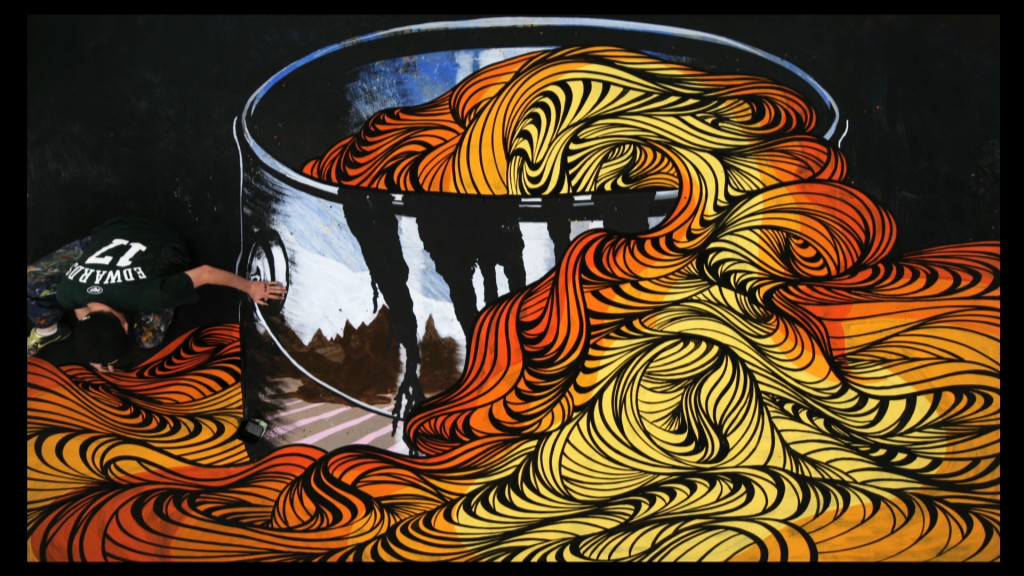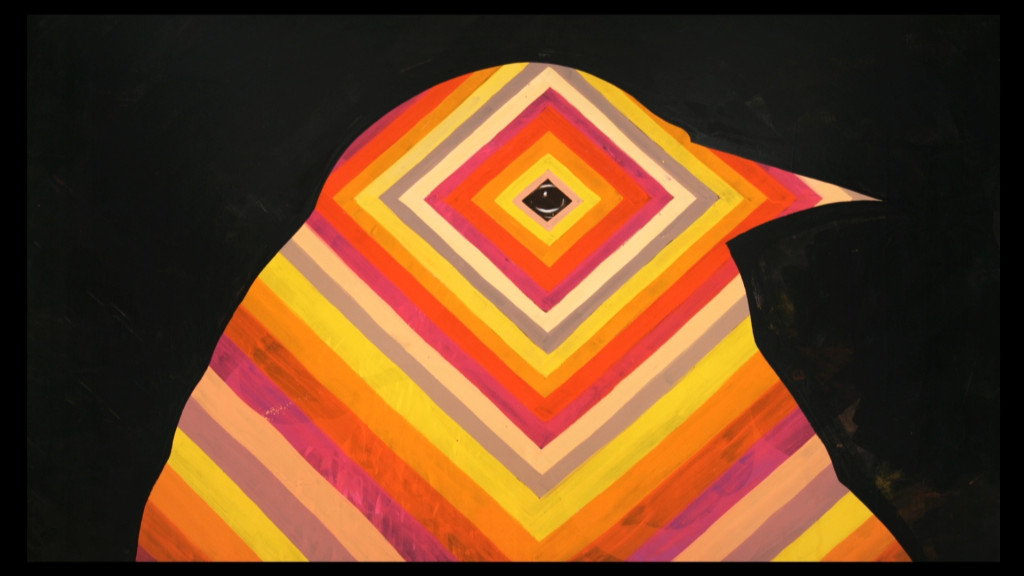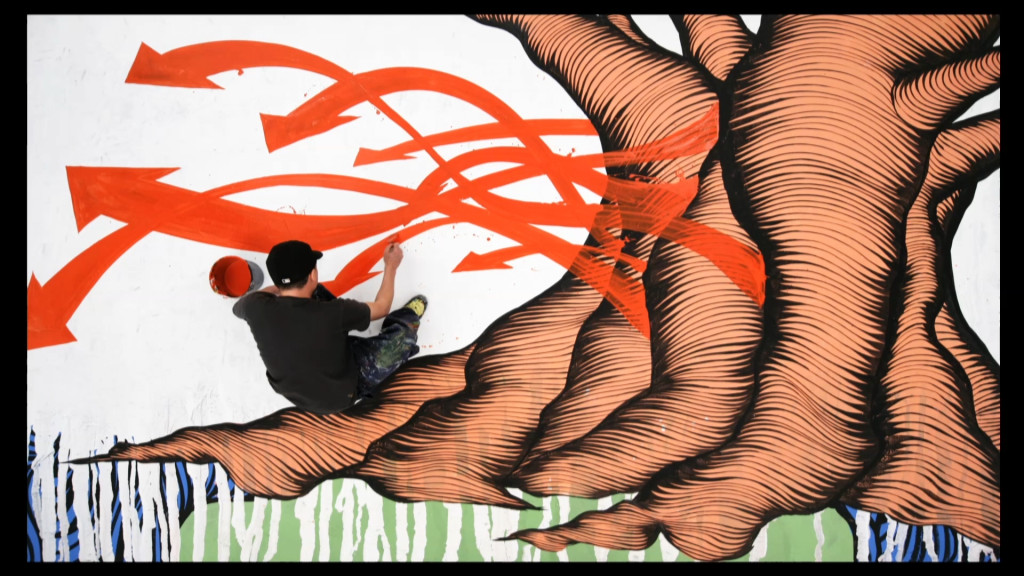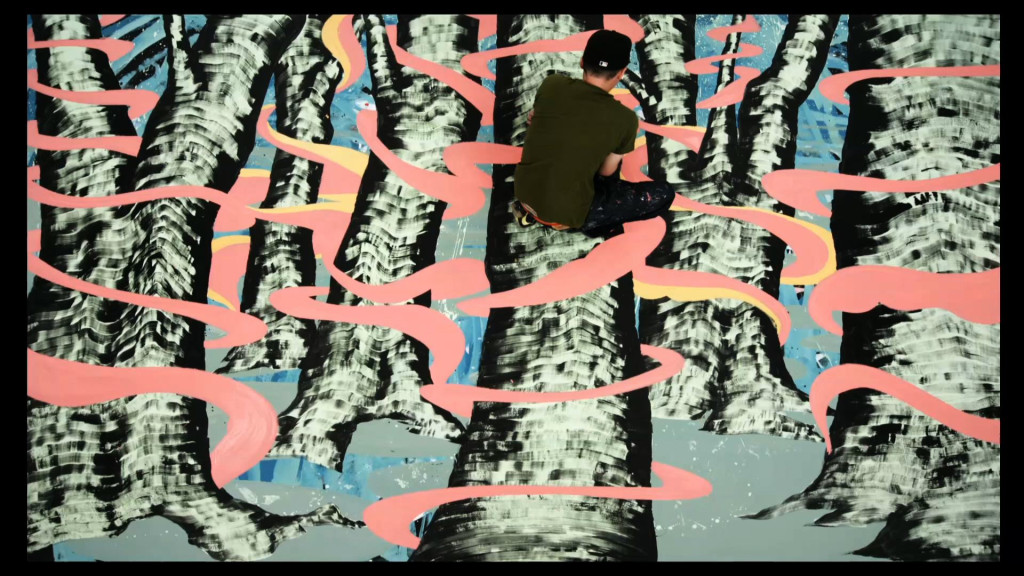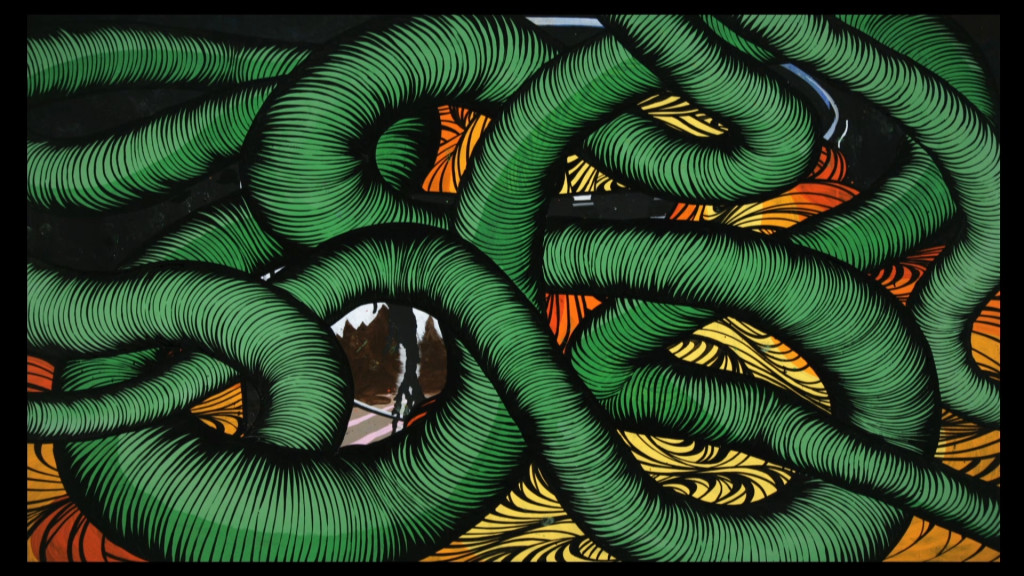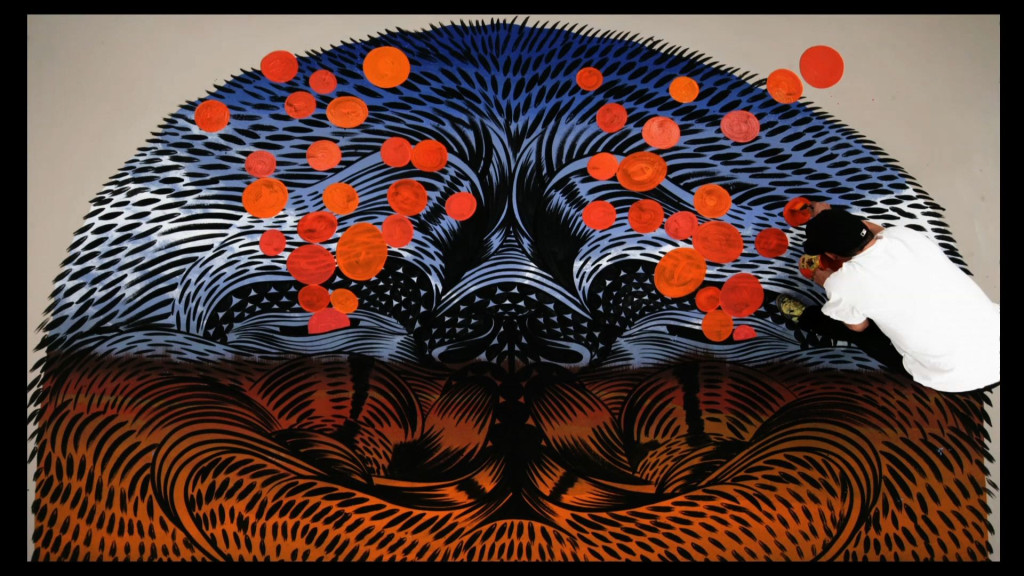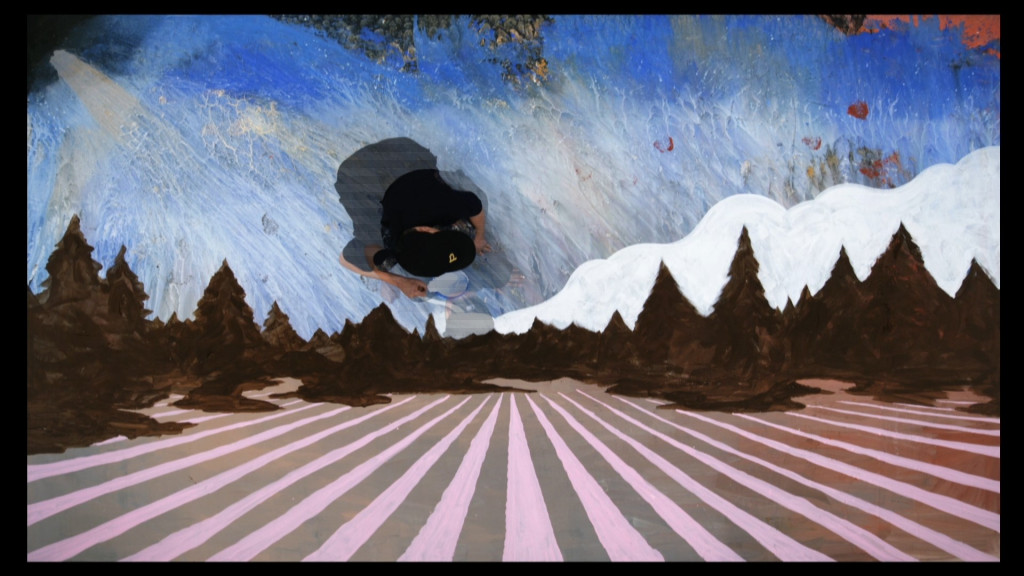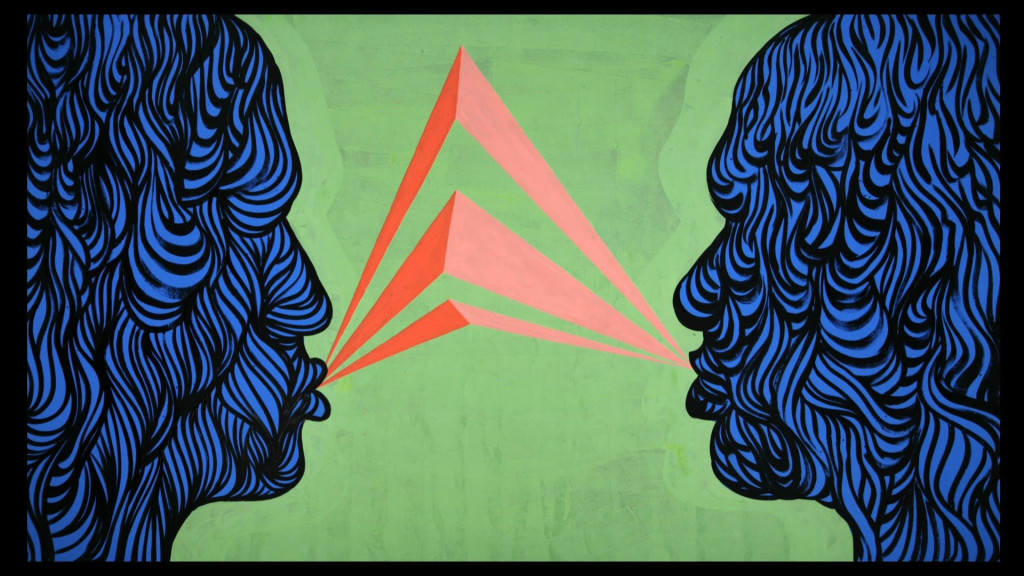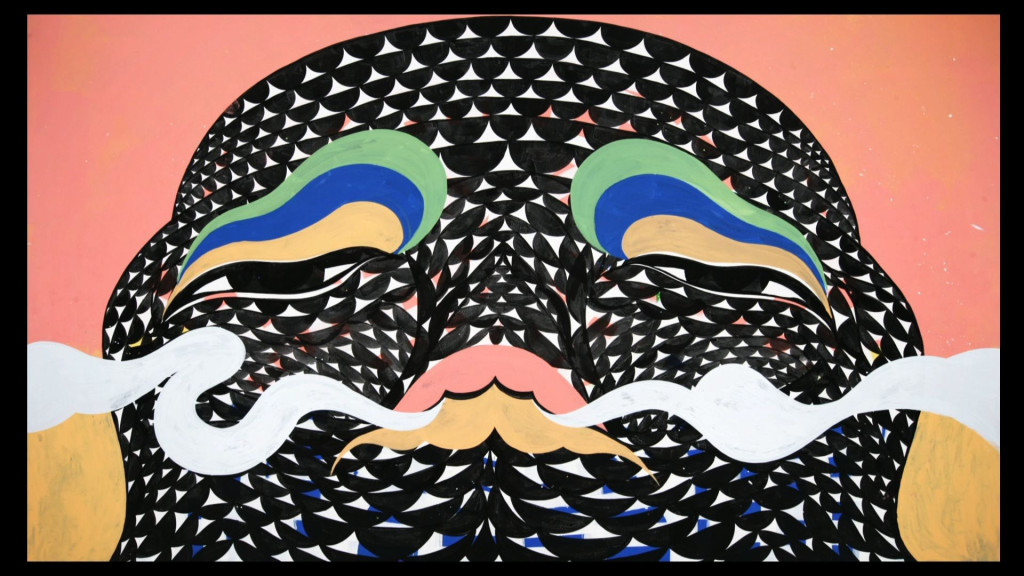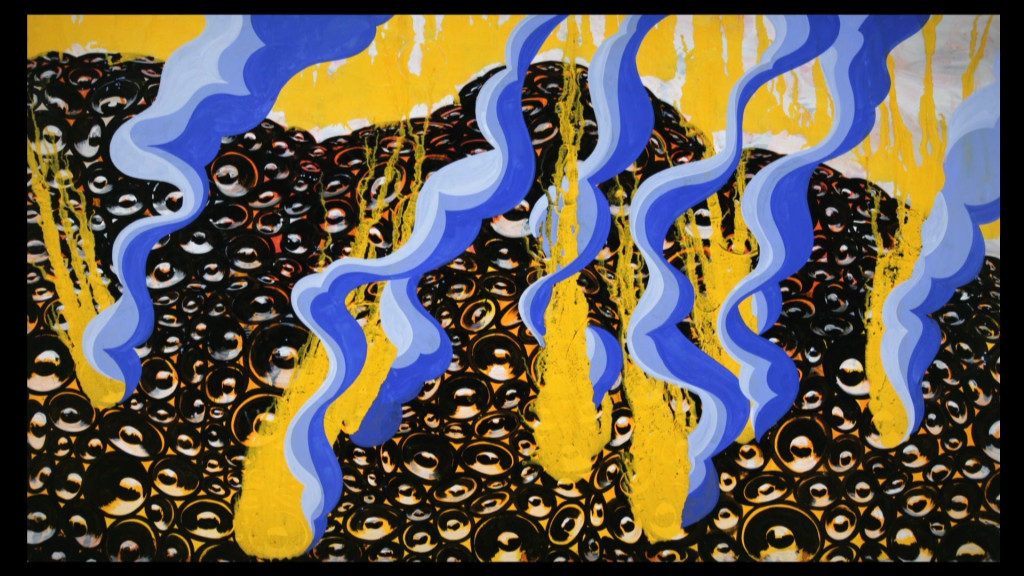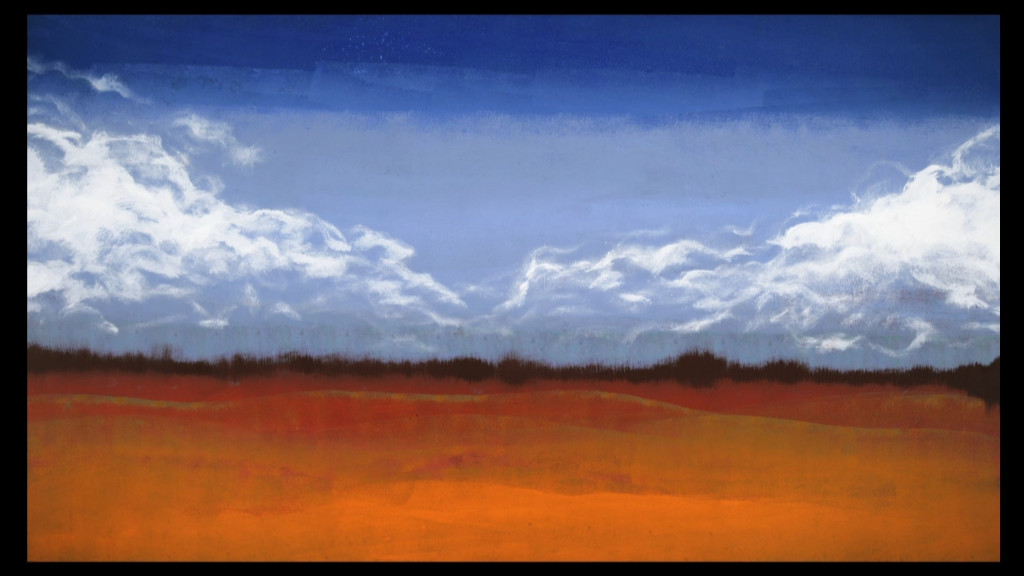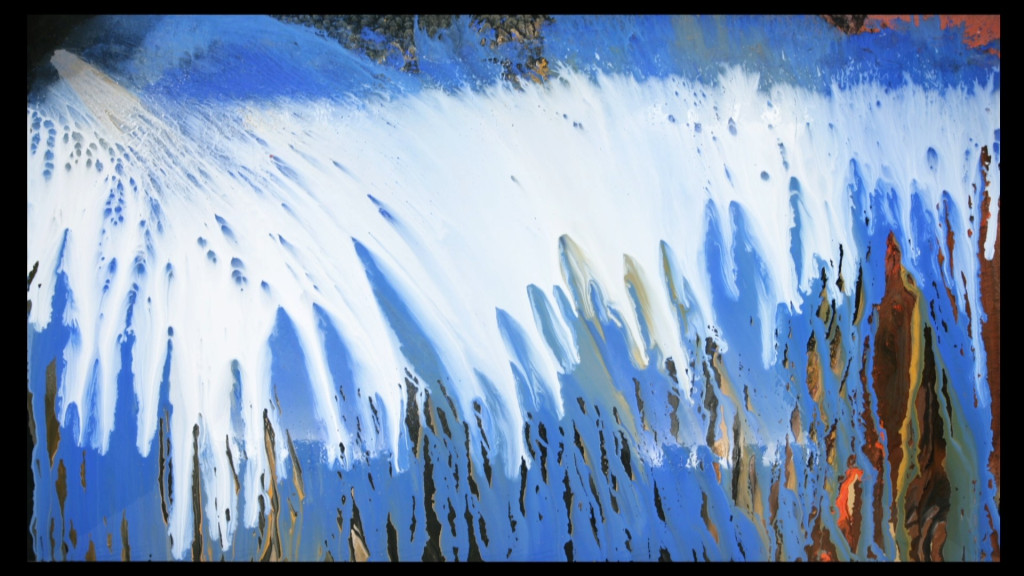Animal
David Ellis
Photography not permitted
Commission, Landmarks, The University of Texas at Austin, 2010
GPS: 30.285844, -97.733286
Multimedia artist David Ellis grew up immersed in various musical styles, from classical jazz to hip-hop. Though he never learned to read music or play it, he employs various elements of music-making in his work. His explorations of movement, change, and rhythm effectively combine his talent for visual representation with his passion for musical expression.
The collaborative and improvisational nature of music influenced a series of painting sessions that Ellis undertook with a group of artists called the Barnstormers in the early 2000s. Captured with time-lapse video, the paintings on vertical surfaces evolved into a style that Ellis called “motion paintings.” For Animal, he positioned a time-lapse camera overhead to photograph his painting process every few seconds. He then compiled the images into a stop-motion video. Similar to a hip-hop track, Ellis’s motion paintings are an assortment of samples, breaks, and disparate moments, all of which combine to create a rhythmic flow of artistic expression.
Animal is the visual record of Ellis’s six-week residency at The University of Texas at Austin. Produced in collaboration with cinematographer Chris Keohane and composed of more than 75,000 still images, the video is inspired by personal conversations and the local environment of Austin. Animal showcases the delights and details of the creative forces of nature that often go unnoticed.
The animation features a kaleidoscope of spectacular creatures, landscapes, and abstractions interspersed with dramatic splashes of paint. The soundtrack, composed by longtime collaborator Roberto Lange, combines a range of unexpected elements that complement the mercurial nature of Ellis’s practice. Animal shifts between moments of freedom, discovery, and surprise that extend from Ellis’s continuous search for ways of representing the universality of art through the rhythms and movement of life.
MORE INFORMATION
In his explorations of movement, change, and rhythm, multimedia artist David Ellis effectively combines his talent for visual representation with his passion for musical expression. The confluence of the visual and the aural typifies the wide range of his artwork, from stop-motion videos to kinetic sculptures to live painting performances. By utilizing various elements of music making—collaboration, improvisation, timing, repetition— Ellis enlivens his creative process and thus his viewer’s experience.
Born in North Carolina in January 1971, Ellis grew up immersed in the various musical styles practiced by several family members. His brother, John, a tenor saxophonist, plays in jazz venues across the globe. Two of his uncles are musicians—one is a classically trained flautist, and another is a piano technician and player. His maternal grandmother was a pump organist who led her church’s choir. Although Ellis lacked the patience to learn how to read and play music as a child, he eventually found ways of expressing rhythms and sounds, but through visual forms.
Growing up in Cameron, a small town in a tobacco-growing region with a population of less than three hundred, Ellis worked in the fields to earn money. At the same time, he also went to the fields to paint his family’s barns and outbuildings, influenced by the graffiti artists he watched in the 1983 PBS documentary Style Wars. With his discovery of rap music via “Super Mix,” a Saturday-night radio program broadcast from the nearby Fort Bragg military base, a love of hip-hop culture soon became central to his development as an artist. He painted murals in nightclubs and even released his own twelve-inch record before enrolling in the visual arts high school program of the North Carolina School of the Arts. His studies continued in New York at the School of the Visual Arts and The Cooper Union, where he received his BFA in 1994.
The artwork and guidance of artists Robert Breer and Hans Haacke were influential in Ellis’s formal education at The Cooper Union. Breer’s motorized sculptures and stop-motion films incorporate humor, chance, repetition, and motion—essential aspects of Ellis’s creations, which also reflect concerns similar to Haacke’s, such as process, freedom, and change. Ellis also found inspiration in the innovative installations of video and found objects by Tony Oursler and Laurie Anderson’s performance art and experimental music. The hip-hop scene remained a major influence, particularly the graffiti art and musical performances of Rammellzee. Ellis also gained valuable experience in realizing large-scale installations by working on the set design and construction of music videos until the late 1990s. By then, hip-hop music had become more commercialized, and Ellis began to distance himself from the scene and returned to North Carolina in 1999.
Music, however, continued to play a part in Ellis’s artistic practice, evidenced by the fluctuating, collaborative, and improvisational style of production that Ellis favors, a style solidified during his return to Cameron. There he led the formation of The Barnstormers, an international group of artists and designers that has since grown to more than forty members. They traveled to the abandoned barns that Ellis once painted as a teenager and, with the encouragement and material resources of the local community, restored and repainted the structures; in the process Ellis’s visual expression was reinvigorated. The Barnstormers’ Fluxus-like collaborative efforts represented Ellis’s belief that artists should work like musicians, that is, combine their talents to realize a piece and enjoy the creative process. Opposed to the clichéd archetype of the solitary, tortured artist, Ellis continues to work in collaborative ways that sustain the love of making art he has had since the age of twelve.
The Barnstormers returned to Cameron every summer until the late 2000s. During that time, Ellis began a series of kinetic sculptures derived from his childhood fascination with player pianos. In 2005 he completed his first in a series of “drum paintings” after his realization that the basic construction of a painting—a sheet of canvas tautly stretched across a frame—allows it to resonate like a percussive instrument when tapped. Adding automated drum actuators to the structure, Ellis was able to make an artwork that played itself and in turn made rhythmic sound visible. Soon after, he began a series entitled Trash Talk, in which he transformed discarded objects from the studio and the street into mechanisms that bang out beats composed by his longtime collaborator Roberto Lange. In many respects, they recall the sculptural machines of Jean Tinguely. However, rather than the sarcasm conveyed through the obsolescence of Tinguely’s self-destructive works, Ellis’s sculptures suggest innovation and regeneration. Moreover, they impart a sense of wonder and levity to the viewer’s (re-)discovery of overlooked, ordinary objects.
Concurrent with the development of his kinetic works, was the production of recorded painting sessions Ellis would later call “motion paintings.” As he and other artists painted a series of improvised, overlapping images on the studio floor, Ellis positioned a time-lapse camera overhead to photograph the process every few seconds. He then compiled the digital images into a stop-motion video, in which the individual frames create the illusion of rapidly evolving imagery when played in sequence. To complete the projects, Ellis and Lange added a layer of abstracted sounds to the visuals, including noises made during the production. These motion paintings are meant to hang on the wall, as would any other paintings, yet the process of their creation becomes a part of the works, as they depict the figure of the artist moving across a plane of changing imagery, building up an image only to sweep or splash a layer of paint across it. These moments of layering are modulations of the artwork that function like the bridge passage of a song. On the one hand, they interrupt and alter the composition, and on the other, they link images together to make the work whole. Similar to a hip-hop track, Ellis’s motion painting is an assortment of samples, breaks, and disparate moments combined to create a rhythmic flow of artistic expression.
Animal, 2010
Ellis’s newest motion painting, Animal, is the visual record of his residency at The University of Texas at Austin. In collaboration with cinematographer Chris Keohane, Ellis aimed to distinguish this work from previous ones by adopting a more intimate method of production and creating a less structured visual format. Inspired by personal conversations and the natural environment, Animal showcases the delights and details of the creative forces of nature that often go unnoticed. The nine-and-a half-minute animation features a kaleidoscope of spectacular creatures, landscapes, and abstractions—in varying colors and shapes—interspersed with dramatic splashes of paint. As Ellis throws colors across the canvas, he allows for moments of play and chance. The placement of the paint is undetermined and free to settle wherever it might land, suggesting the unpredictability of not only the natural world, but also the artistic process. To compliment the mercurial nature of Ellis’s practice, Roberto Lange’s soundtrack combines a range of unexpected elements. At any moment, one hears vocal excerpts, percussive breaks, ambient noises, ritualistic chanting, or distorted beats. Although Animal differs from Ellis’s previous motion paintings, its shifting moments of freedom, discovery, and surprise extend from Ellis’s continuous search of ways to represent the universality of art through the rhythms and movement of life.
Kanitra Fletcher is the curator of Landmarks Video. She is a doctoral candidate in the Department of History of Art and Visual Studies at Cornell University, writing her dissertation on mid-twentieth century black American avant-garde artists. Fletcher earned her BA in English Literature at Rutgers University—New Brunswick and her MA in Latin American Studies at the University of Texas at Austin.
Boehl, Dan. “Interview: David Ellis.” ... might be good 147. (07 May 2010).
Peiter, Sebastian, and Goetz Werner. Guerrilla Art. London: Laurence King Pub., 2009.
Smith, Roberta. “David Ellis: Dozens.” New York Times. (18 July 2008): E27.
Wolff, Rachel. “Winged Victory.” ArtNews. (June 2008): P40.
Garfield, Joey. “David Ellis.” Juxtapoz Art & Culture Magazine. (March 2007): 56-67.
As part of the renovation of the ART building, Landmarks commissioned David Ellis to create the first video in the university’s public art collection. The result is Animal, a nine-and-a-half-minute video that inaugurates Landmarks Video and underscores the Department of Art & Art History’s commitment to emerging forms of visual expression.
Ellis was selected for the ways in which his work invites and celebrates collaborative processes. He undertook a residency in the Visual Arts Center (VAC) galleries for six weeks in Spring 2010 during which he engaged with faculty, students and the public, featuring a day-long celebration of his work at Co-Lab. Animal premiered at the opening of the VAC in September 2010.
This project was funded by the College of Fine Art’s Art building capital improvement project. The media station was designed by LakelFlato Architects and is located in the ART building atrium on the corner of East 23rd Street and San Jacinto Boulevard.
Landmarks would like to thank:
Leadership
Andrée Bober and Landmarks
Pat Clubb and University Operations
Douglas Dempster and the College of Fine Arts
Kenneth Hale and the Department of Art & Art History
Landmarks Advisory Committee
William Powers and the Office of the President
Bob Rawski and the Office of Facilities Planning and Construction
David Rea and the Office of Campus Planning
Samuel Wilson and the Faculty Building Advisory Committee
Project Team
Andrée Bober, curator and director, Landmarks
David Ellis, artist
Chris Keohane, production manager
Roberto Lange, composer
Lewis McNeel, Bill Aylor, and LakelFlato Architects
Robert Mercado, Office of Facilities Planning and Construction
Nicole Vlado, project manager, Landmarks
Jade Walker, Visual Arts Center
Special Thanks
Dan Fergus and Russell Etchen, Domy Books
Kanitra Fletcher, curatorial contributor
Sean Gaulager, Co-Lab
Leah Griffin, education and external affairs, Landmarks
Alexis Lanman, event coordinator
Mark Silva, Visual Arts Center
Susan B.A. Somers-Willett, poet
Wild Animals I Have Known
by Susan Somers-Willett
1: Three Ways to Begin a Story
How to know a wild animal?
I do not mean have one in a cage
but to really know its story.
The story, while it is wild,
is so much like another.
We cannot be sure
that it really is the same
next time we meet.
But once in awhile
there arises an animal.
Once or twice,
while it is wild,
a story is a crow.
2: Story in Which the Words are Crows
The life of a wild animal may be far more
exciting than that of many human beings.
Such a terrific story, silvery like a nickel.
Our most intelligent birds
rave on the edge of the city
on and on, doggedly
so little crows
with a language wonderfully
human echo
Be on your guard!
and venture to fly.
Danger repeated the cry,
alighted on a tree close by, and stayed.
3: Story in Which Leaves Make a Burning Sound
I found that sometimes a little difference in
sound makes a great difference in meaning.
Thus anger, whose root idea is danger.
O crows. Pairs and trios
chasing each other
with a sound like distant thunder.
They were making love
and pairing off, their voices
stealing gently through the woods,
so that no rustle made
a smart blow, a pair
of crows, a wife.
4: The Origins of Pleasure
O shiny things.
He could not explain why he enjoyed them—
why he collects postage stamps,
why he prefers pearls—
he saw at once so many little adventures.
Not that these did him harm, but they were
cruel tricks:
to eat the new laid eggs,
what we ourselves do to the hens in the barnyard
with soft wings and falsetto voice:
Here. Begin again.
5: Story in Which the Crows Talk
In a row, nervous darlings
sometimes seem to make speech.
The rabble of silly little crows:
An umbrella is not a gun.
Rows begin to plume.
They know how to worry a fox into giving up
half his dinner.
They have never tasted horses’ eyes.
In full feather
all the signals and words command
pleasure, clamor.
Mount!
Bunch!
Scatter!
Form line!
The cry turned
pines to rage.
6: Two Facts About Crows
There is only one time when a crow is a fool.
There are no hospitals for sick crows.
7: Story in Which the Story Eats Crow
I saw remains, then
all was clear—
the bones
had not lied.
All around were signs of struggle.
Alas! So many hundreds of crows
to beware of
the wind in which
they had lived.
—A palimpsest of Ernest Thompson Seton’s story “Silverspot: The Story of a Crow”
and in response to David Ellis’s motion painting Animal

